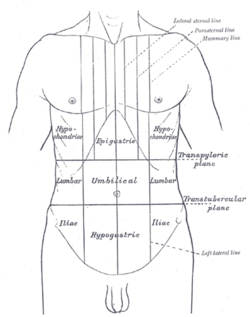Hypochondrium
This article needs additional citations for verification. (July 2016) |
| Hypochondrium | |
|---|---|
 Thorax and abdomen. | |
 Front of abdomen, showing surface markings for liver, stomach, and great intestine. | |
| Details | |
| Identifiers | |
| Latin | regio hypochondriaca |
| TA98 | A01.2.04.002 |
| TA2 | 256 |
| FMA | 20390 |
| Anatomical terminology | |
In anatomy, the division of the abdomen into regions can employ a nine-region scheme, in which the hypochondrium is the upper part of the abdomen on either side, inferior to (below) the thorax, in the area of the lower ribs.[1]
The liver is in the right hypochondrium; the spleen and much of the stomach are in the left hypochondrium. The epigastrium intervenes.[citation needed]
Definitions, etymology, and modern controversies
The word derives from Greek: ὑποχονδρος: hupochondros, meaning abdomen, or literally "under cartilage" or "below the cartilage". The word once referred only to the soft portion of the abdomen between the rib cage and the navel (the region once believed to be the seat of hypochondriasis), but it is not used that way in modern anatomy's schemes for the regions of the abdomen.
However, because the hypochondriac areas of the abdominal cavity lie deep to the lower costal cartilages, the etymological notion of "below the cartilage" still works, thanks to the ambiguity of "under/below" (which can be interpreted as either "inferior to" or "deep to").[citation needed]
Some sources have disputed usage of the term for the parts of the anterior abdominal wall below the costal margins. The region named the right hypochondrium exists anatomically, but is almost totally under the chest wall. In clinical situations, the parts of the abdominal wall just below the right and left costal margins are referred to as the right and left hypochondriac regions respectively.
Significance of region
Clinically speaking, symptoms and signs arising from this region are of great importance and have a specific list of diseases in their differential diagnoses.[2][unreliable medical source?]
Additional images
-
Front view of the thoracic and abdominal viscera
References
- ^ thefreedictionary.com
- ^ M. Aroon Kamath, M.D. The right hypochondrium… Is it really “right”? A territorial dispute. Doctors Lounge website. Retrieved August 18 2010.
See also
External links
- Abdominal Viscera Basics - Page 1 of 10 anatomy module at med.umich.edu

